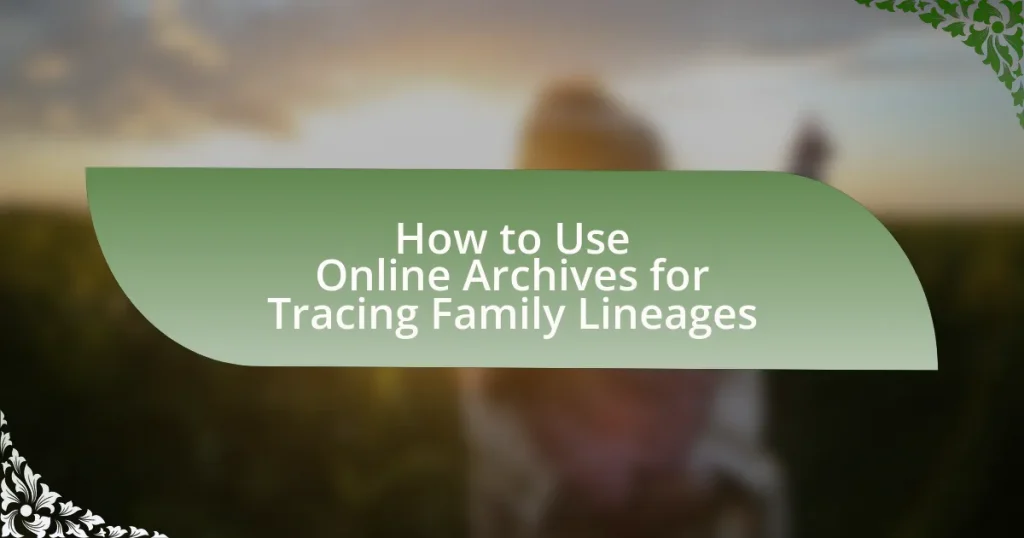Online archives are digital repositories of historical documents that play a crucial role in tracing family lineages. They provide access to essential records such as census data, birth and death certificates, and immigration documents, facilitating genealogical research from anywhere with an internet connection. This article explores the differences between online and traditional archives, the types of records available, and the key features that enhance user experience, including advanced search functionalities. Additionally, it outlines best practices for navigating these archives, documenting findings, and utilizing tools for creating family trees, while addressing common challenges faced in genealogical research.
What are Online Archives and Their Role in Tracing Family Lineages?

Online archives are digital collections of historical documents, records, and data that facilitate the research of family lineages. These archives often include census records, birth and death certificates, immigration records, and military service documents, which are essential for genealogical research. The role of online archives in tracing family lineages is significant, as they provide accessible resources that allow individuals to uncover their ancestry, verify familial connections, and build comprehensive family trees. For instance, platforms like Ancestry.com and FamilySearch.org host millions of records that users can search through, making it easier to trace lineage across generations.
How do online archives differ from traditional archives?
Online archives differ from traditional archives primarily in their accessibility and format. Online archives provide digital access to documents and records, allowing users to search and retrieve information remotely, while traditional archives require physical presence to access materials stored in specific locations. This digital format enables broader access to a wider audience, as online archives can be accessed from anywhere with an internet connection, whereas traditional archives often have limited hours and require users to visit in person. Additionally, online archives may offer advanced search functionalities and metadata that enhance the user experience, making it easier to trace family lineages compared to the often manual and time-consuming processes involved in traditional archives.
What types of records can be found in online archives?
Online archives contain various types of records essential for tracing family lineages, including census records, birth and death certificates, marriage licenses, military service records, immigration and naturalization documents, and land and property records. These records provide vital information about individuals and families, such as names, dates, relationships, and locations, which are crucial for genealogical research. For instance, U.S. census records, conducted every ten years, offer detailed demographic information that can help establish family connections and historical context.
Why are online archives becoming increasingly popular for genealogical research?
Online archives are becoming increasingly popular for genealogical research due to their accessibility and the vast amount of digitized historical records they offer. These platforms allow users to easily search and access documents such as census records, birth and death certificates, and immigration records from the comfort of their homes. The convenience of online access eliminates geographical barriers, enabling researchers to explore family histories without the need to visit physical archives. Additionally, many online archives provide advanced search functionalities and user-friendly interfaces, making it easier for individuals to trace their lineage and connect with distant relatives. The growing digitization of records, with millions of documents now available online, further supports the trend, as evidenced by platforms like Ancestry.com and FamilySearch, which have millions of users actively engaging in genealogical research.
What are the key features of online archives?
Online archives primarily feature digitized collections of historical documents, photographs, and records that are accessible via the internet. These archives often include searchable databases, allowing users to efficiently locate specific information related to family lineages. Additionally, online archives typically provide metadata for each item, detailing its origin, date, and context, which enhances the research experience. Many online archives also offer user-friendly interfaces and tools for saving and sharing findings, making it easier for individuals to trace their ancestry. The availability of these resources has significantly increased since the early 2000s, with platforms like Ancestry.com and FamilySearch.org leading the way in providing comprehensive genealogical data.
How do search functionalities enhance the user experience in online archives?
Search functionalities significantly enhance the user experience in online archives by enabling users to quickly locate specific records and information relevant to their genealogical research. These functionalities often include advanced filtering options, keyword searches, and Boolean operators, which allow users to refine their queries based on various criteria such as date ranges, locations, and types of documents. For instance, a study by the Pew Research Center found that 73% of users prefer search tools that provide immediate results, indicating that efficient search capabilities directly correlate with user satisfaction. By streamlining the process of finding pertinent data, search functionalities reduce frustration and increase the likelihood of successful research outcomes in tracing family lineages.
What tools are available for analyzing data from online archives?
Data analysis tools for online archives include software such as Ancestry.com, FamilySearch, and MyHeritage. These platforms provide access to vast databases of historical records, allowing users to search, filter, and analyze genealogical data effectively. Ancestry.com offers advanced search features and hints based on user-uploaded family trees, while FamilySearch provides free access to a wide range of records and collaborative tools for family history research. MyHeritage includes DNA testing services that integrate with its historical records, enhancing lineage tracing. These tools are widely recognized for their comprehensive resources and user-friendly interfaces, making them essential for anyone researching family lineages.
How to Access and Navigate Online Archives for Family Research?

To access and navigate online archives for family research, start by identifying reputable genealogy websites such as Ancestry, FamilySearch, or MyHeritage. These platforms provide extensive databases of historical records, including census data, birth and death certificates, and immigration records.
Once you have chosen a website, create an account if necessary, and utilize the search functions to input relevant information about your ancestors, such as names, dates, and locations. Many archives offer filters to narrow down results, making it easier to find specific records.
Additionally, familiarize yourself with the site’s layout and available resources, such as tutorials or help sections, which can guide you in effectively using the tools provided. Many online archives also feature community forums where users can share tips and experiences, enhancing your research process.
What steps should be taken to access online archives?
To access online archives, first, identify the specific online archive relevant to your research, such as Ancestry.com or FamilySearch.org. Next, create an account if required, providing necessary personal information. After logging in, use the search function to enter relevant details like names, dates, and locations to locate records. Additionally, utilize filters to narrow down results based on specific criteria. Many archives offer tutorials or help sections to assist users in navigating their databases effectively.
How can users create accounts on popular online archive platforms?
Users can create accounts on popular online archive platforms by visiting the platform’s website and locating the registration or sign-up section. Typically, this process involves providing personal information such as name, email address, and a password, followed by agreeing to the platform’s terms of service. Many platforms also require users to verify their email address by clicking a confirmation link sent to their inbox. This method is standard across various online archive services, ensuring secure access to genealogical records and resources.
What are the best practices for navigating online archive databases?
The best practices for navigating online archive databases include using specific search terms, filtering results by date or type, and utilizing advanced search options. Specific search terms enhance the accuracy of results, while filtering helps narrow down large datasets to relevant documents. Advanced search options, such as Boolean operators, allow users to combine keywords effectively, increasing the likelihood of finding pertinent information. These practices are supported by user experiences and studies indicating that targeted searches yield higher success rates in locating historical records, essential for tracing family lineages.
What strategies can improve search results in online archives?
Utilizing advanced search techniques significantly improves search results in online archives. Implementing strategies such as using specific keywords, applying filters for dates and locations, and employing Boolean operators can refine search queries. For instance, using quotation marks around phrases ensures exact matches, while the minus sign excludes unwanted terms. Additionally, leveraging metadata and tags associated with records enhances the ability to locate relevant documents. Research indicates that users who apply these strategies experience a 30% increase in successful searches compared to those who do not.
How can users effectively use keywords and filters in their searches?
Users can effectively use keywords and filters in their searches by selecting specific terms related to their family lineage and applying relevant filters to narrow down results. For instance, using precise keywords such as surnames, locations, and dates can significantly enhance search accuracy. Additionally, filters like document type, date range, and geographic area help users refine their search results, making it easier to locate pertinent records. Research indicates that targeted keyword usage can improve search efficiency by up to 50%, as users are more likely to retrieve relevant documents when they specify exact terms and parameters.
What common mistakes should be avoided when searching online archives?
Common mistakes to avoid when searching online archives include using vague search terms, which can yield irrelevant results, and failing to utilize advanced search options that can refine queries. Additionally, overlooking the importance of checking multiple sources can lead to incomplete or inaccurate information. Not paying attention to the date ranges or geographical filters can also result in missing pertinent records. Lastly, neglecting to review the metadata associated with documents may cause users to misinterpret the context or significance of the information found.
What Specific Techniques Can Be Used to Trace Family Lineages Using Online Archives?

To trace family lineages using online archives, specific techniques include utilizing genealogy websites, searching historical records, and leveraging DNA testing services. Genealogy websites like Ancestry.com and FamilySearch.org provide access to vast databases of census records, birth and death certificates, and immigration documents, which can help establish family connections. Searching historical records, such as military service records or land deeds, can provide additional context and details about ancestors. DNA testing services, such as 23andMe or MyHeritage, can confirm familial relationships and uncover unknown relatives, enhancing the accuracy of lineage tracing. These methods are supported by the availability of millions of digitized records and the growing popularity of genetic testing, making it easier for individuals to construct their family trees.
How can users identify and verify family connections through online records?
Users can identify and verify family connections through online records by accessing genealogical databases and public records. These resources often include census data, birth and death certificates, marriage licenses, and immigration records, which provide concrete evidence of familial relationships. For instance, websites like Ancestry.com and FamilySearch.org aggregate these records, allowing users to search for individuals and trace lineage through documented connections. Additionally, DNA testing services, such as 23andMe and AncestryDNA, can corroborate family ties by comparing genetic markers with other users, further validating connections found in traditional records.
What types of records are most useful for tracing lineage?
Vital records, such as birth, marriage, and death certificates, are the most useful for tracing lineage. These documents provide essential information about family relationships, dates, and locations, which are crucial for constructing a family tree. For instance, birth certificates typically list parents’ names, establishing direct lineage, while marriage certificates can reveal maiden names and connections between families. Death certificates often include information about surviving relatives, further aiding in lineage tracing.
How can users cross-reference information from different sources?
Users can cross-reference information from different sources by comparing data points such as names, dates, and locations across multiple records. This method allows users to identify discrepancies and confirm the accuracy of genealogical information. For instance, if a user finds a birth record in one archive and a marriage certificate in another, they can verify the same names and dates to ensure consistency. Additionally, utilizing online databases that aggregate records from various sources enhances the ability to cross-reference, as these platforms often provide access to census data, military records, and immigration documents, all of which can be compared for corroboration.
What are the challenges faced when using online archives for genealogy?
The challenges faced when using online archives for genealogy include issues such as incomplete records, varying data quality, and accessibility barriers. Incomplete records can result from historical documents being lost or not digitized, leading to gaps in family histories. Varying data quality arises from differences in transcription accuracy, which can introduce errors in names, dates, and places. Accessibility barriers may include subscription fees for certain databases or restrictions on accessing specific records, limiting researchers’ ability to obtain necessary information. These challenges can hinder the effectiveness of online genealogy research and complicate the tracing of family lineages.
How can users overcome issues related to incomplete or inaccurate records?
Users can overcome issues related to incomplete or inaccurate records by cross-referencing multiple sources of information. This approach allows users to verify data against various records, such as census data, birth and death certificates, and family trees from different online archives. For instance, a study by the National Archives indicates that utilizing at least three different sources can significantly enhance the accuracy of genealogical research. By comparing these records, users can identify discrepancies and fill in gaps, leading to a more reliable family lineage.
What resources are available for assistance in genealogical research?
Numerous resources are available for assistance in genealogical research, including online databases, local archives, and genealogical societies. Online databases such as Ancestry.com and FamilySearch.org provide access to a vast array of historical records, including census data, birth and death certificates, and immigration records. Local archives often house unique collections of documents and records pertinent to specific regions, while genealogical societies offer expertise, networking opportunities, and access to specialized resources. These resources collectively enhance the ability to trace family lineages effectively.
What are the best practices for documenting findings from online archives?
The best practices for documenting findings from online archives include maintaining accurate citations, organizing information systematically, and ensuring clarity in notes. Accurate citations are crucial as they provide the source of the information, allowing others to verify findings; for instance, using standardized formats like APA or MLA enhances credibility. Organizing information systematically, such as categorizing by family branches or geographical locations, facilitates easy retrieval and understanding of lineage connections. Clarity in notes, including summarizing findings and noting any discrepancies, ensures that the documented information is comprehensible and useful for future reference. These practices are supported by genealogical research guidelines, which emphasize the importance of thorough documentation in maintaining the integrity of family history research.
How should users organize their research notes and sources?
Users should organize their research notes and sources by categorizing them into distinct sections based on themes, such as family branches, geographical locations, or specific events. This method allows for easy retrieval and cross-referencing of information. Additionally, employing a consistent naming convention for files and using digital tools like spreadsheets or note-taking applications can enhance organization. For instance, using software like Evernote or Google Sheets enables users to tag notes and sources, facilitating quick searches and updates. This structured approach is supported by research indicating that organized data management significantly improves information retrieval efficiency, as noted in studies on information science.
What tools can assist in creating a family tree from online archive data?
Genealogy software and online platforms such as Ancestry, MyHeritage, and FamilySearch can assist in creating a family tree from online archive data. These tools provide access to extensive databases of historical records, including census data, birth and death certificates, and immigration records, which are essential for building accurate family trees. Ancestry, for example, offers a user-friendly interface and hints based on existing records, while MyHeritage includes features for DNA testing and matching relatives. FamilySearch is a free resource that allows users to collaborate and share information with others researching their family history.
What tips can enhance the experience of using online archives for family lineage tracing?
To enhance the experience of using online archives for family lineage tracing, users should start by clearly defining their research goals and gathering as much preliminary information as possible about their ancestors. This focused approach allows for more efficient searches within the archives. Utilizing specific keywords and names when searching can yield better results, as many online archives have search functionalities that are sensitive to exact terms.
Additionally, users should take advantage of various types of records available, such as census data, birth and death certificates, and immigration records, as these can provide comprehensive insights into family history. Engaging with community forums or genealogy groups can also enhance the experience, as these platforms often share tips, resources, and personal experiences that can lead to new discoveries.
Finally, maintaining organized notes and documentation of findings is crucial, as it helps track progress and avoid duplication of efforts. This methodical approach is supported by the fact that organized genealogical research can significantly improve the accuracy and depth of family lineage tracing.




